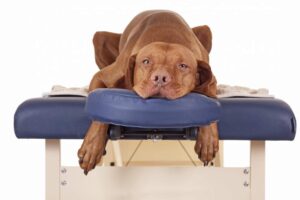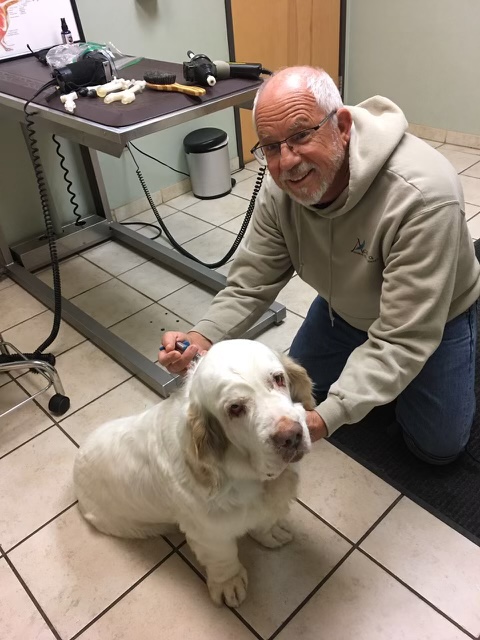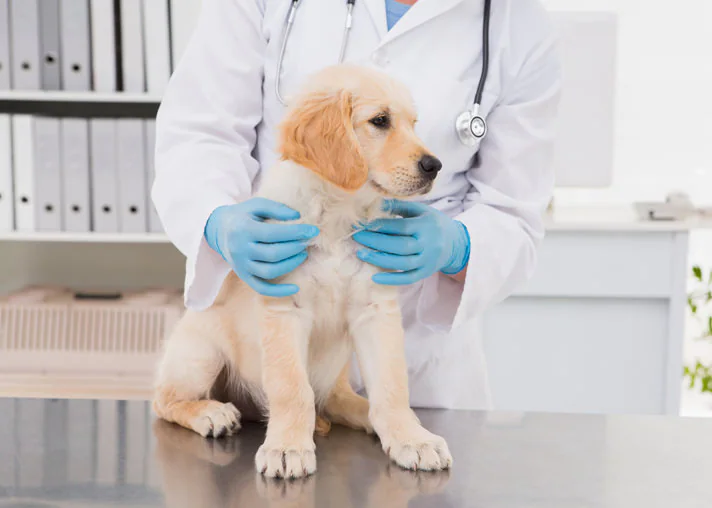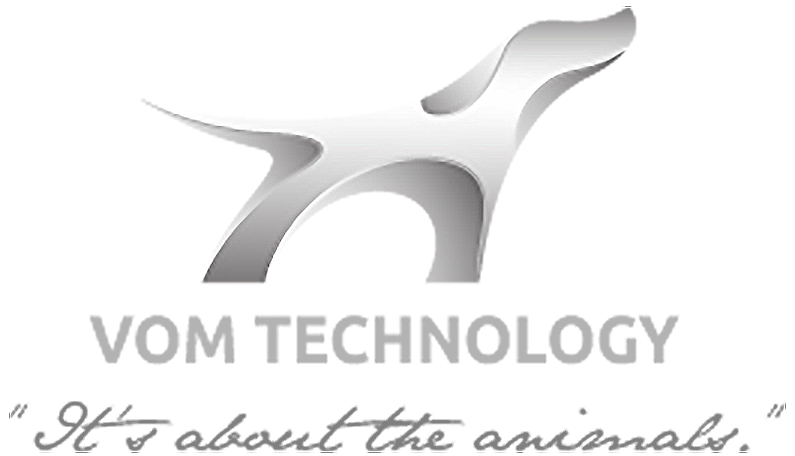What is VOM?
Veterinary Orthopedic Manipulation (VOM) is a healing technology that locates areas of the animal’s nervous system that has fallen out of communication, and re-establishes neuronal communication and thus induces healing. VOM is singularly the most simple, effective and safe healing modality in veterinary care to date. For the VOM practitioner it is an exquisitely objective, fast and easy to apply technology that takes a minimum amount of time to master and whose scope of application appears has yet to be fully appreciated.

Introduction to the Red Violet Laser
The importance of up regulation using the red violet laser
What can VOM Treat?
- Acute and non-acute lameness
- Progressive lameness
- Hip Dysplasia-like syndromes
- IV disc disease
- Progressive myelopathies (“down in the rears” dogs)
- Urinary and fecal incontinence
- Unilateral lameness
- Wobbler’s Disease
- Diseases of the knee

- Esophageal disease
- Increased of decreased GI mobility disease
- Digestive disorders
- Performance problems
- Behavioral problem
- Agility dysfunction
- Endocrine disease
- Many more
How it works
All chiropractic modalities have one thing in common in that they all reduce the vertebral subluxation complex by providing motion or force to the fixated or subluxated joint.
Spinal Injury = Neuronal Subluxation Syndrome = Pathological Read
Neuronal Subluxation + Motion (force) = Subluxation Reduced
So, if you put motion into a joint that is associated with a neuronal subluxation sign, a pathological read, you reduce the subluxation. It is that simple. All the various types of chiropractic techniques have this motion or force into the subluxated joint in common. VOM delivers its force with a hand-held device. It looks a bit like a spring-loaded doorstop. Your VOM practitioner has extensive references covering the research investigating the principles portrayed above and can provide them upon request. These references are replete in chiropractic journals.

Frequently Asked Questions
click the arrow to expand
Is Veterinary Orthopedic Manipulation (VOM) chiropractic care?
No! VOM exists in between veterinary medicine and chiropractic care. It has similarities to some of the chiropractic modalities and functions by restoring function by reducing “subluxations” as is done in chiropractic care. It uses a hand-held device that is used in a popular human chiropractic technique called “Activator Methods” but it is not to be confused with that technique. The differences between VOM and Chiropractic care are significant and distinct. VOM exists in a gray area between both professions (Veterinary and Chiropractic) and benefits from the positive aspects of both, a hybrid, and thus more effective than either by themselves.
VOM is not animal chiropractic care and thus is not taught by the American Veterinary Chiropractic Association (AVCA). VOM is not recognized by the AVCA (the AVCA does not recognize anything it does not teach). The Animal Veterinary Medical Association (AVMA) does not recognize veterinary chiropractic care or the AVCA for now.
Dr Inman has formerly presented at with American Holistic Veterinary Medical Association, Association of Pet Dog Trainers, the Maine Veterinary Medical Association, and the German Shepherd Clubs of America, to name a few.
Is VOM an animal version of Activator Methods, a human chiropractic technology using the hand-held device?
No. Activator Methods developed by Arlan Fuhr D.C. uses the spinal accelerometer and relies exclusively on listings demonstrated by leg length checks which are anatomical subluxation signs.
Why is VOM so accurate?
VOM is so accurate because it finds and reduces all neuronal subluxations. All neuronal subluxations have a pathological reflex demonstrably associated with them.
A pathological reflex is like a knee jerk response. It is either there or it is not. It is an objective means to determine the presence and reduction of neuronal subluxation. The pathological read is not “partially there”, “kinda there”, or “almost there” adding a factor of subjectivity to interpretation. VOM is a precisely objective science.
Why is VOM so successful?
Because VOM locates all the neuronal subluxations present in the animal regardless of whether clinical listings are present and reduces them and confirms their reduction. Inherent in the VOM Technology is a built-in rescheduling protocol that inserts the patient on a self-regulating readjustment interval. Again, an easy, objective science.
How can VOM be that easy?
Why not? Who says that a healing modality has to be complicated, difficult and expensive? Who says it should take hundreds of hours to learn and perfect?
A technology that goes to the root of the problem, a simple technology that relies on the animal’s innate ability to heal itself, one that re-establishes communication with the pet’s ability to heal itself, will be easy, powerful and effective.
Is VOM effective on horses?
You bet! All the reads we see in the dog and the cat are magnified in the horse. Areas usually devoid of subluxations in the shoulder areas of dogs and cats are hot spots in the equine.
Many of the AVCA-trained veterinary chiropractors have taken the VOM Seminar will choose to use the device to locate all the subluxations and then proceed to manually adjust the horse using the AVCA techniques.
Why haven’t I heard of the VOM Technology before?
Because it works!
That may not make sense at first, but consider this: if the VOM Technology does what it appears to do, it makes a lot of techniques, surgeries and medications obsolete.
The professionals that provide those techniques, surgeries and medications will be placed in academic and financial jeopardy. These are the people that control publications in the field and control licensure and applications. AKA politics.
How can I get more information?
For starters, you may click on “Contact Us” for more information on the VOM Technology, how to find/choose a VOM practitioner, what it will cost, etc.
Also, you may find more information in related fields by investigating acupuncture, acupressure and classic manual veterinary chiropractic care.
Veterinary Myofascial Release
The term “myofascia” refers to the muscle, “myo”, and the connective tissue that surrounds and attaches the muscle, “fascia”, hence, “Myofascial”.
The release that is achieved with this technique is therapeutic on many levels:
- Primary reduction of subluxations
- Return muscles to normal tonus and function
- Enhance healing and recovery during VOM Therapy
- Strengthen and rehabilitate atrophied muscles
- Re-establish range of motion and posture
- Improve strength and performance
VMR was developed out of a desire to enhance the healing benefits of the VOM Treatment Technology. Specifically it was the skeletal muscle tension associated with subluxation that was being addressed.
It was found that there were lines of correction in the domestic animals that, if released with this technique,would allow the muscle and tendon fixations associated with subluxations to relax.


Returns Original Muscle Tone
One of the goals of VOM subluxation reduction is to return the muscle to its original tone. It was found that VMR could easily accomplish this effect. At the same time, there is no trauma to the pet.
Previously, physical therapy was used to rehabilitate these muscles and tendons but the process was usually arduous and painful as it can sometimes be in the human. The animal does not understand why its limbs are being forced through painful ranges of motion and generally sees the whole process as unpleasant and therefore is uncooperative.
VMR contacts lines of correction in the domestic animal that releases these tensions and does it in seconds. There is absolutely no pain or discomfort to the patient. To release these areas, the practitioner has to treat the patient with several rapid-fire pulses, directed to specific sites.
These pulses have to be fast enough and with enough force that human hands and even the VOM Adjusting Device would not be effective. The pulses have be 5lb to 60lb and less than 20 milliseconds in duration. The pulses have to be as rapid as 10-15 per second. This is why VMR requires a special device.
For More Information on VOM
Please contact
Patricia Kallenbach DVM, CVCP, LMT
352-220-0183
